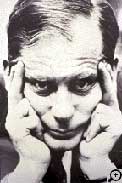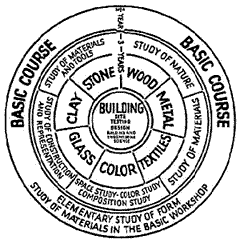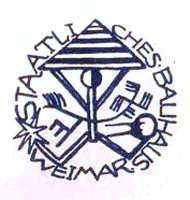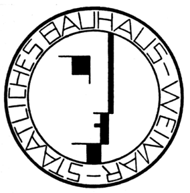| The Origins of the Bauhaus | Walter Gropius | |||
Along with its Russian counterpart Vkhutemas, the Bauhaus was the early model of the modern art school. The Bauhaus curriculum combined theoretic education and practical training in the educational workshops. It drew inspiration from the ideals of the revolutionary art movements and design experiments of the early 20th century. A woodcut (shown right) depicted the idealized vision of Walter Gropius, a "cathedral" of design. |
 Lyonel Feininger, Cathedral, woodcut, Cover of 1st program of Bauhaus April 1919 |
 Gropius was greatly affected by the horrors of WWI and wanted to create a school where industrial methods were used not used for destructive wars but for the betterment of social conditions. |
|
Bauhaus (Building House) The Bauhaus was a state-sponsored initiative to integrate the artist and the craftsman while bridging the gap between art and industry. "The unity of arts had of course been a central tenet of the late 19th-century Arts and Crafts movement, and the ideals of William Morris influenced Gropius's planning for the school. But the Bauhaus was the antithesis of the Arts and Crafts movement in fundamental ways. No more romance of hand making in the countryside: its emphasis was urban and technological, and it embraced 20th-century machine culture. Mass production was the god, and the machine aesthetic demanded reduction to essentials, an excision of the sentimental choices and visual distractions that cluttered human lives."1
|
Walter Gropius Henry van de Velde (Belgian), headmaster at the School of Arts and Crafts in Weimar, Germany, was asked to leave the country at the outbreak of World War I. He was replaced by the German architect Walter Gropius who, in 1919, reorganized the school under the name Bauhaus School of Design. Gropius began his career working under architect Peter Behrens, a founder of the Deutsche Werkbund. Gropius applied the principles of the Werkbund to the Bauhaus curriculum, in effect creating a laboratory to teach and expand the existing Deutsche Werkbund theories of design. |
The Basics Curriculum "Students at the Bauhaus took a six-month preliminary course that involved painting and elementary experiments with form, before graduating to three years of workshop training by two masters: one artist, one craftsman. They studied architecture in theory and in practice, working on the actual construction of buildings. The creative scope of the curriculum attracted an extraordinary galaxy of teaching staff. Among the stars were Paul Klee, Wassily Kandinsky, Oskar Schlemmer, the painter and mystic Johannes Itten, László Moholy-Nagy, Josef Albers and Marcel Breuer. Bauhaus students were in day-to-day contact with some of the most important practicing artists and designers of the time. The school, masterfully marketed, acquired a reputation and an influence out of all proportion to its physical reality as a single institution in the German provinces. The name Bauhaus soon became a bogey word to adherents of the bourgeois style that it so vigorously opposed. German mothers told their children: "If you don't behave, I'll send you to the Bauhaus." But to those who responded to its uncompromising vision of the future, the term Bauhaus had a certain magic. The school came to be known for the marvelous masked balls and kite processions, experimental light and music evenings, and "Triadic" abstract ballets that it organized. These occasions welded students of many ages and nationalities together into a community. The Bauhaus was the beginning of the art school as an alternative way of life. 1 |
|
Karl Peter Röhl |
1922 |
||
| Footnotes | |||
1 |
2 Design for Bauhaus symbol Bauhaus-online.de |
||
| Copyrights | |||
| ©Designhistory.org 2011 | For Permission Info click here | ||



